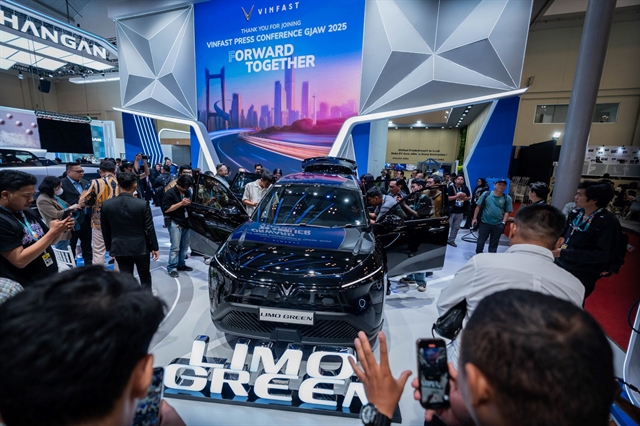 Life & Style
Life & Style

Việt Nam’s picturesque landscape and mystic ancient monument have inspired Japanese artist Toba Mika to create several profound artworks, which are on display at the Đà Nẵng Museum of Chăm Sculpture.
 |
| Walls and shadows: A Hội An street captured by Toba Mika. |
ĐÀ NẴNG — Việt Nam’s picturesque landscapes and mystical monuments have found katazome expression at the hands of Japanese artist Toba Mika.
A selection of her works is on display at the Đà Nẵng Museum of Chăm Sculpture.
More than a thousand years old, katazome, or stencil dyeing, is a Japanese paste-resist surface design technique for cloth and paper. The complicated process incorporates elements of both printmaking and painting, and relies on simple non-toxic materials such as rice paste, natural pigments and soymilk. Katazome was used in creating samurai outfits, clothes of kyogen comic performing artists, or kimonos.
 |
| What I’ve done: Artist Toba Mika introduces her paintings to visitors at the exhibition in Đà Nẵng. — Photo courtesy of organiser |
Mika, who has a Masters degree from the Kyoto City University of Arts, has developed a new style of painting by using the traditional katazome method.
When she first came to Việt Nam in 1994, the artist immediately felt an invisible connection between katazome paintings and Việt Nam’s scenery and cultural heritage, and this prompted her to make several trips to Việt Nam.
She found inspiration in everyday scenes, like the railway track in Hà Nội that passes very close to a row of houses and a lone boat on the Hương River in Huế early in the morning, the mystical Chăm sculptures in the Mỹ Sơn Sanctuary and the typical yellow walls in Hội An City.
Her unique paintings have been exhibited several times in Việt Nam, attracting great attention and admiration from Vietnamese art enthusiasts.
 |
| Urban track: A katazome painting by Toba Mika of a scene in the heart of Hà Nội. |
Some of the previous shows held here were at the Toba Mika Exhibition to commemorate the 30th Anniversary of Japan - Việt Nam Diplomatic Relations in 2003; an exhibition called Playing the Eternal Music of Heart at the Royal Palace in Huế in 2005; and the Nara and Hà Nội Bound together with Katazome exhibition that commemorated both the 1,300th anniversary of Nara Heijo-kyo Capital and the millennial anniversary of Thăng Long-Hà Nội in 2010.
In Japan, Mika has received 19 awards including “Urban Culture Incentive Award” and the “Kyoto Arts New Artist Award”. She received the Foreign Minister’s Award for her contribution to promoting friendship between Japan and Việt Nam through her works and cultural activities. The Vietnamese Government has also given her its Cultural Testimonial Award.
The ongoing Toba Mika’s Katazome Paintings Exhibition, which has been brought to Đà Nẵng by Menard, is an activity held to welcome the APEC Summit. It will remain open to the public until November 11.
The Đà Nẵng Museum of Chăm Sculpture is at 2, Hai Tháng Chín Street. — VNS




